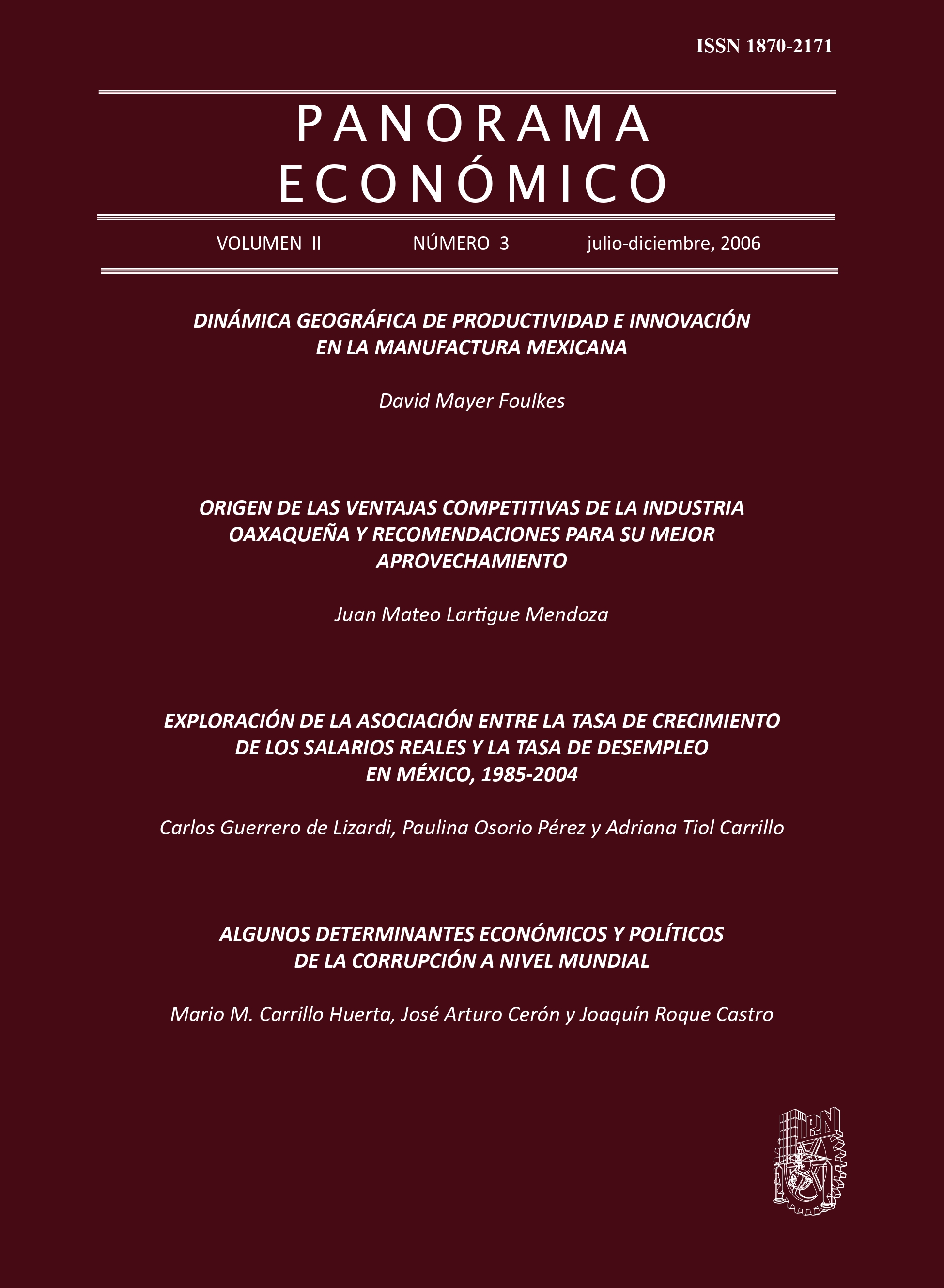Dinámica geográfica de productividad e innovación en la manufactura mexicana
Contenido principal del artículo
La aglomeración industrial es caracterizada por fuerzas centrípetas y centrífugas que pueden medirse con la variedad industrial y el promedio de firmas por ramo. Una revisión de la teoría de geografía económica explica cómo estos indicadores se correlacionan con mayores niveles de productividad, y con competencia y congestión, respectivamente. Estimativas por niveles y dinámicas de productividad, capital físico, salario promedio, escala de producción, variedad industrial y promedio de firmas, realizadas para una base municipal correspondiente a 1993 y 1998, confirman la existencia de una muy significativa dinámica geográfica industrial en México. Observamos que entre las fuerzas centrípetas y centrífugas existen retroalimentaciones tanto positivas como negativas, ya que la competencia inhibe la formación de nuevos ramos industriales. Un subsidio local a su introducción estabilizaría la dinámica industrial y promovería su productividad y tasa de innovación. Encontramos además que las inversiones en infraestructura de transporte, y la transformación democrática mexicana, son positivas para la escala industrial y su intensidad de capital.
Aghion, P.; Howitt, P.; and Mayer-Foulkes, D. (2005). “The Effect of Financial Development on Convergence: Theory and Evidence”, Quarterly Journal of Economics, vol. 120, issue 1, Feb.
Aghion, Philippe, Nick Bloom, Richard Blundell, Rachel Griffith and Peter Howitt (2005). “Competition and Innovation: An Inverted-U Relationship”, Quarterly Journal of Economics 120 (May): 701-28.
Armington, P. S. (1969), “A theory of demand for products distinguished by place of production”, IMF Staff Paper, Vol. 16, 159-178.
August Lösch (1954). Die räumliche Ordnung der Wirtschaft (Jena: Gustav Fischer, 1940; 2nd ed., 1944); W. H. Woglom (tr.), The Economics of Location (New Haven, Conn.: Yale University Press).
Baldwin, R.; Forslid, R.; Martin, P.; Ottaviano, G.; and Robert-Nicoud, F. (2003). Economic Geography and Public Policy. Princeton University Press. Princeton, N.J.
Davis, Donald R. (1998). “The Home Market, Trade, and Industrial Structure”, American Economic Review, American Economic Association, vol. 88(5), pages 1264-76, December.
De Remes, Alain (2000), Banco de datos electorales a nivel municipal 1980-1999 (CD-ROM), México, Centro de Investigación y Docencia Económicas, A. C., 2000.
Feenstra, Robert C.; Markusen, James A. y Rose, Andrew K. (1998). “Understanding the Home Market Effect and the Gravity Equation: The Role of Differentiating Goods”, NBER Working Papers 6804, National Bureau of Economic Research, Inc.
Forslid R. and Ottaviano (2003). “An Analytically Solvable Core-Periphery Model”, Journal of Economic Geography 3, pp.229-240.
Fujita M., Krugman P. and A. Venables (1999). The Spatial Economy: Cities, Regions and International Trade (Cambridge (Mass.): MIT Press).
Gula Roji (1994), Gran atlas de carreteras, México, 1994.
Head, Keith; Mayer, Thierry; y Ries, John, 2002. “On the Pervasiveness of Home Market Effects”, Economica, London School of Economics and Political Science, vol. 69(275), pages 371-90, August.
Helpman, E. (1990). “Monopolistic competition in trade theory”. Special Paper in International Economics16, Princeton University, International Finance Section.
Howitt, P. and Mayer-Foulkes, D. (2005). “R&D, Implementation and Stagnation: A Schumpeterian Theory of Convergence Clubs”, Journal of Money, Credit and Banking, Vol. 37, No. 1, Feb.
International Economic Review, 43, pp. 409-436.
Krugman, P. “The Hub Effect: Or, Threeness in International Trade” In Theory Policy and Dynamics in International Trade: Essays in Honor of Ronald Jones, edited by J. P Neary, Cambridge, Ma, Cambridge University Press, 1993.
Krugman, Paul (1980). “Scale Economics, Product Differentiation, and the Pattern of Trade”, American Economic Review, American Economic Association, vol. 70(5), pages 950-59, December.
Krugman, Paul (1991). “Increasing Returns and Economic Geography”, Journal of Political Economy 99, 483-99.
Krugman, Paul R. y Venables, Anthony J. (1995). “Globalization and the Inequality of Nations”, The Quarterly Journal of Economics, MIT Press, vol. 110(4), pages 857-80.
Ludema, Rodney D. y Wooton, Ian (2000). “Economic geography and the fiscal effects of regional integration”, Journal of International Economics, Elsevier, vol. 52(2), pages 331-357, December.
Martin, P y C.A Rogers (1995). “Industrial location and public infrastructure”, Journal of International Economics 39: pp. 335-351.
Mori, Tomoya y Turrini, Alessandro (2005). “Skills, agglomeration and segmentation”, European Economic Review, Elsevier, vol. 49(1), pages 201-225, January.
Ottaviano G. J. Thisse and T. Tabuchi, (2002), “Agglomeration and Trade Revisited”, International Economic Review, 43, pp. 409-436.
Puga, Diego (1999). “The rise and fall of regional inequalities”, European Economic Review, Elsevier, vol. 43(2), pages 303-334, February.
Sánchez Almanza, Adolfo (1998). “Marginación e ingreso en los municipios de México, 1970-1990. Análisis para la asignación de recursos fiscales”, tesis de maestría en sociología, Facultad de Ciencias Políticas y Sociales, Universidad Nacional Autónoma de México, México, 1998.
Venables, Anthony (1996). “Equilibrium locations of vertically linked industries”, International Economic Review 37, 341-359.
Detalles del artículo

Esta obra está bajo una licencia internacional Creative Commons Atribución-NoComercial-SinDerivadas 4.0.







